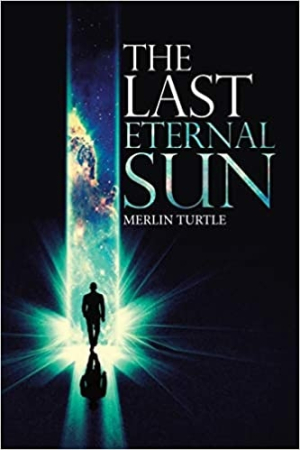The Last Eternal Sun
With its complex blend of mythological elements and advanced tech, the science fiction novel The Last Eternal Sun wonders about the origins of the universe, and about humanity’s place inside of it.
In Merlin Turtle’s labyrinthian science fiction novel, The Last Eternal Sun, human beings escape to the stars—but leave some people behind.
Ambrose, a druid, is in constant search for knowledge about the universe. He lives on a planet in the Dyson ring, which orbits a star. But what he thinks he knows about himself is incorrect; his place in humanity’s story is much stranger than he imagines.
Ambrose goes on a quest to find the tomb of an ancient, godlike engineer who helped to create the Dyson ring, but his search has ramifications that stand to linger throughout time and space. He is already well into his search when the story opens. It is revealed that Ambrose is not just looking for the tomb; his darker intentions are hinted at, and he immediately seems fascinating and complex.
Along the way, Ambrose meets others, including a boat full of singing pirates whose mysterious captain is also on a quest. He and Ambrose join forces to head to the moon. Later in the text, they stumble upon a lost technological wonder that is defended by an advanced race. They meet fin folk and conclude their search in a funny, intriguing manner. Its tone tongue-in-cheek, the book also includes elements like a space pig police force that contribute to its otherworldly sensibilities well.
Ambrose’s world is immersive, though many of its details center on the technological marvel that circles the sun, in the sweet spot where Earth used to be. It is suggested that Earth collapsed; those who wished to survive headed to the stars. Only intriguing, near-forgotten technology hints at humanity’s past. All of this is built upon fascinating scientific notions of space, time, and space exploration.
The text is sectioned off as its story expands across the centuries, becoming less about Ambrose and more about the human drama of colonizing the stars. Background material is added via appendices that help to explain the cultures of its characters, illuminating otherwise vague aspects of Ambrose’s story.
With a complex blend of mythological elements and advanced tech, the science fiction novel The Last Eternal Sun wonders about the origins of the universe, and about humanity’s place inside of it.
Reviewed by
Jeremiah Rood
Disclosure: This article is not an endorsement, but a review. The publisher of this book provided free copies of the book and paid a small fee to have their book reviewed by a professional reviewer. Foreword Reviews and Clarion Reviews make no guarantee that the publisher will receive a positive review. Foreword Magazine, Inc. is disclosing this in accordance with the Federal Trade Commission’s 16 CFR, Part 255.

